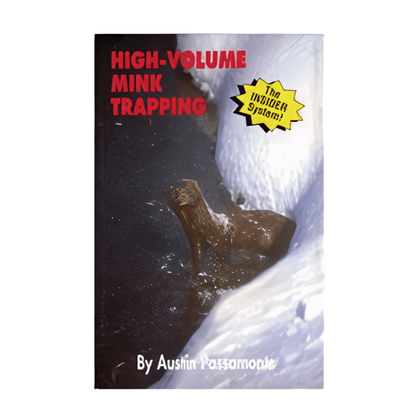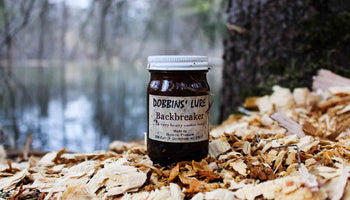

IN THIS ARTICLE
Muskrat Trapping Equipment
The amount of equipment needed for muskrat trapping is simple and cheap. Due to their small, size any old #1 longspring or #1 1/2 longspring or coilspring trap will work. I prefer a #1½ coilspring for a couple of reasons. They are heavy enough to drown a muskrat, large enough to catch a coon or mink that stumbles along, and lastly, they catch the muskrat high enough on the leg to prevent them from ringing out. The only modifications you’ll want to do is to reduce the pan tension down to nearly nothing and possibly extend the trap chain. The extended trap chain will allow them to jump into the water and drown, whether you’re trapping in open water or through the ice.
A #110 bodygrip or #150 bodygrip is very effective for setting trails and runs. I personally prefer the Bridger #150 because of its slightly larger jaw opening. It just seems to fit in and block an area better when setting blind sets.
The last trap I run for ‘rats is called a colony trap. These traps are made out of steel mesh and have a door that swings up on each side. Colony traps are designed for catching multiple muskrats at a time and are best used in the entrances of dens and in runs. There have been times where I’ve had a colony trap so full of muskrats that the door had to be bent in order to get them out of there.
I use the same staking setup for water and ice trapping. The stake is just a chunk of lathe about four feet long. If you’re not worried about theft, it’s a good idea to spray paint the top of it a bright color or tie some fluorescent ribbon on it. The wood lathe can blend into the cattails, making it easy to walk by a set without seeing it. Be aware that raccoon can pull the lathe out, so if you’re targeting them as well you may want to switch to something a bit sturdier like rebar stakes. If you do catch an incidental coon in a muskrat set, I have found that the longer chain and lathe acts as a drag and they get tangled up pretty quickly in the cattails and aquatic vegetation. The lathe also works well for stabilizing bodygrips both above and below the water.
Not much else is needed for trapping muskrats other than some wire for tying your traps off and a good pliers. I do suggest buying a good pair of gauntlets as they will save your hands from getting beat up and will keep them warm and dry.
Some people prefer to use floats, especially when chasing spring ‘rats. Later in this chapter I’ll include directions on how to create a simple float using spare 2x4s. The HAGz muskrat setup utilizing 3/8” fiberglass rods have also gained a lot of popularity since its introduction on the market.
ATtractants
Lures for muskrats are optional and boils down to personal preference. It is my belief that a muskrat lure helps attract them to your trap location, but is not a necessary item. Bait can be an important part of making floats successful, with carrots and apples being a great option. Like any kind of trapping, the main thing is just placing your traps in the right location so you’re not depending on the attractant to draw them in.
Muskrat Huts
Trapping muskrat huts will be one of your best set locations. When you look at the huts you’ll see where the ‘rats have been climbing up unto them out of the water. These little trails are a great place to set your trap. If you don’t see a clear trail, just set your traps around the edges of the hut. If you want to use some lure just dribble it so that the muskrat has to cross your trap in order to investigate it. You’ll want your traps bedded on vegetation and to be slightly below the surface of the water. If the vegetation is too far out of the water, you can use your first to create an indent that will fill with water, creating a perfect place for your trap.
Wire your trap off to the lathe and place the lathe a couple feet away from the side of the hut. The muskrat's natural instinct when caught in a trap is to dive underwater for safety. This will allow the weight of the trap to drown them. Just make sure that between your stake and the trap is free of cattails and grass as muskrats can get tangled up very easily. You can set each hut multiple times allowing for more than one catch per hut when you check your traps.
Feed Beds
Feed beds are small platforms of aquatic vegetation ranging from six inches wide to larger than a foot. The muskrats use these platforms to sit on out of the water when eating. Lots of times you can see if these feed beds are being used because there will be chunks of white vegetations and roots that fell when the muskrat was feeding on it. It’s very simple to set them, just place your trap(s) where the muskrats are climbing up out of the water onto them. Lure them if you so choose. Some feed beds are so small that the weight of the trap will actually sink them. All you have to do is drag your hand around it to get more weeds to pile on top of it. This will give you enough matter to stabilize and support the weight of your trap. Stake the trap the same way you do when setting huts.

Muskrat Toilets
Toilets are just small platforms that the muskrats use as a latrine. Lots of time they will be on floating logs, tipped over trees, or rocks and you’ll see muskrat fresh muskrat dropping scattered about on it. If the toilet is on a rock you can just use other rocks in the area to build up a suitable surface to hold your trap in place. Setting on logs can be a bit more tricky, and this is where some trapping wire comes in really handy. Just use the wire to fasten the trap to the log. Don’t fully twist the wire though, you want the trap to fall of when the muskrat is trapped so that it can swivel and hopefully drown.

Blind Sets For Muskrats
Blind sets and can be utilized above or below water with great success. When using them above water just look for little trails with mud and shallow water. You can use either a foothold or conibear to set these. If there isn’t a good place to drown the muskrat than I’d definitely go with a #110 bodygrip or #150 bodygrip. No lure should be used as the muskrat and possibly mink are already traveling these trails.
When running underwater blind sets you’ll want to use either a bodygrip or colony trap. You can set bank den entrances, hut entrances, or run. When trying to set underwater blind sets you’re going to want to move slowly so that you don’t dirty the water up with silt. When you see the entrance or run just place your trap in front of it and stabilize it with your lathe.
The last blind set I commonly use is setting traps in culverts going from slough to slough. If the water is shallow I’ll set a foothold in the bottom of it. This can catch coon, mink, and muskrats. If the culvert is submerged than a bodygrip or colony trap is the go-to for muskrats and the occasional mink. I always find it amazing how you can take muskrats out of a culvert day after day.

Muskrat Float Sets
These sets are about as simple as it gets and are mainly suggested for spring ‘rat trapping. I’ve heard of many guys in South Dakota catching 1000s in the spring just with floats. All you have to do is make a float out of wood and foam that holds multiple traps. You can place bait and lure in the middle of them if you so choose. The muskrats will step in your trap when climbing up on them. The main down fall with floats is that they can be bulky and cumbersome when using them in numbers.
How to Make a "Muskrat Motel" Float
Here's how to make the “Muskrat Motel” float that I learned from the article in Fur-Fish-Game:
- You’ll need one 8-foot-long 2x4 board.
- Cut the 2x4 into five equal pieces, each measuring 16 inches long.
- Arrange and screw the five pieces together to form the float frame, following the “Muskrat Motel” design.
- In the middle of the top board, run a screw from the bottom up. This will hold your bait in place.
- Attach a #1½ coilspring trap to each side of the float. Wire each trap securely to the float so they stay in place.
- To anchor the float, you have two options:
- Drill a hole through the center board and insert a fiberglass rod to stake it in place.
- Or, tie a piece of light rope to the float with a brick on the other end to act as an anchor.
Note: Credit for this design goes to the original, unknown author in Fur-Fish-Game.
Keep in mind that these are open water sets targeting primarily muskrats in this section. There are other water sets that work very well for harvesting muskrats including the pocket set, bottom edge set, etc. These sets work good for coon and mink as well as the bonus muskrat. Whenever possibly I suggest using a set that allows you to target more than one species of furbearer as it improves your catch rate and adds enjoyment to your trapline.



